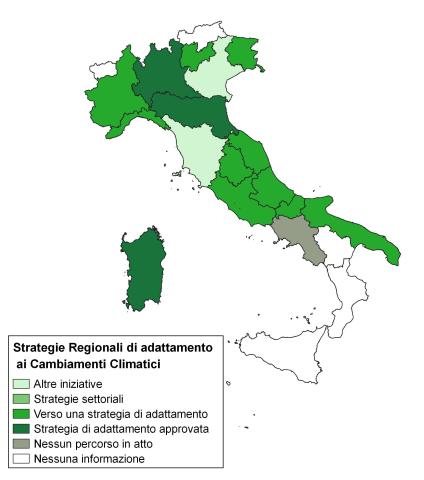FROST DAYS
Data aggiornamento scheda:
This indicator describes trends in cold extremes across Italy, specifically quantifying the number of frost days, defined as days with daily minimum air temperature less than or equal to 0°C. In 2024, a reduction of approximately 13.7 frost days was observed compared to the 1991–2020 climatological baseline.
TROPICAL NIGHTS
Data aggiornamento scheda:
The indicator describes the trend in extreme heat events in Italy, specifically representing the number of days with a minimum daily air temperature exceeding 20 °C. In 2025, an increase of approximately 25.2 tropical nights was observed compared to the climatological average for the 1991–2020 reference period.
CUMULATIVE PRECIPITATION
Data aggiornamento scheda:
The indicator describes the amount and spatial distribution of precipitation in Italy. In 2024, total annual precipitation in Italy was about 8% higher than the average value for the reference period 1991–2020. Northern and north-central areas were characterised by positive anomalies, while most of the remaining part of the country recorded widespread negative anomalies.
VERY HOT DAYS
Data aggiornamento scheda:
The indicator describes the trend in extreme heat events in Italy, specifically representing the number of days with a daily maximum air temperature exceeding 35 °C. In 2024, an increase of approximately 11.4 extremely hot days was observed compared to the climatological average for the 1991–2020 reference period.
SUMMER DAYS
Data aggiornamento scheda:
The indicator describes the trend in extreme heat events in Italy, specifically representing the number of days with a maximum daily air temperature exceeding 25 °C. In 2024, an increase of approximately 6.9 summer days was observed compared to the climatological average for the 1991–2020 reference period.
HEAT WAVES
Data aggiornamento scheda:
The indicator describes the trend of intense heat events in Italy. A heat wave is defined as an event lasting at least 6 consecutive days during which the maximum temperature exceeds the 90th percentile of the daily maximum temperature distribution for the same period of the year over the 30-year climatological reference period. The indicator counts the number of days characterized by such heat waves in a given year. In 2024, an increase of approximately 29.3 heat wave days was observed compared to the average value calculated over the reference 30-year period (1991–2020).
AVERAGE TEMPERATURE
Data aggiornamento scheda:
The indicator describes the trend of mean temperature in Italy.
The increase in mean temperature recorded in Italy over the last thirty years has often exceeded the global average over land. In 2024, the mean temperature anomaly in Italy, relative to the 1991–2020 climatological baseline, was +1.33 °C—higher than the global land surface anomaly of +1.03 °C. In Italy, 2023 ranked as the warmest year in the entire annual time series starting from 1961. Since 2000, temperature anomalies relative to the 1991–2020 baseline have consistently been positive, except for four years (2004, 2005, 2010, and 2013).
HEATWAVES AND MORTALITY
Data aggiornamento scheda:
This indicator measures the health impact of heatwaves on the elderly population (aged 65 and over) across 27 Italian cities included in the National Heatwave Health Prevention and Warning Plan. The plan is implemented by the National Centre for Disease Prevention and Control (CCM) of the Ministry of Health and coordinated by the Epidemiology Department of the Lazio Regional Health Service (DEP Lazio). The cities are equipped with Heat Health Watch Warning (HHWW) systems to provide forecasts and alerts.
The summer of 2023 (15 May – 15 September) was characterized by temperatures above the seasonal reference average. Despite these elevated temperatures, observed mortality in the elderly population remained generally within expected levels. Monthly impact assessments highlighted increases in mortality rates associated with heatwave episodes during July and August in several monitored urban areas.
This indicator provides critical information for monitoring climate-related health risks and supports adaptation strategies aimed at reducing adverse health effects of heatwaves on vulnerable population groups.
GLACIER MASS BALANCE
Data aggiornamento scheda:
The indicator is calculated for a limited sample of Alpine glaciers and represents the algebraic sum of ice mass gained through snowfall accumulation and mass lost through melting during the ablation period. Glacier mass balance data provide a fundamental measure for assessing the "health status" of glaciers.
Analysis of data from 1995 to 2023 shows that, for the glaciers considered collectively, the cumulative mass balance exhibits significant losses, ranging from nearly 25 meters water equivalent for the Basòdino glacier to over 50 meters water equivalent for the Caresèr glacier, corresponding to an average annual mass loss exceeding one meter water equivalent.
CLIMATE CHANGE ADAPTATION STRATEGIES AND PLANS
Data aggiornamento scheda:

Regional Climate Change Adaptation Strategies and Plans are the primary tools available to regional authorities to address the impacts of climate change and implement actions aimed at reducing territorial vulnerabilities. In Italy, the number of adopted regional strategies and plans remains very limited. Despite the absence of a binding regulatory framework and a national programmatic reference context, there are ongoing initiatives, projects, and climate vulnerability studies that are expected to lead toward the formal adoption of first Adaptation Strategies and subsequently Climate Change Adaptation Plans. The challenge posed by climate change urgently requires the definition and implementation of concrete actions to enhance territorial resilience.